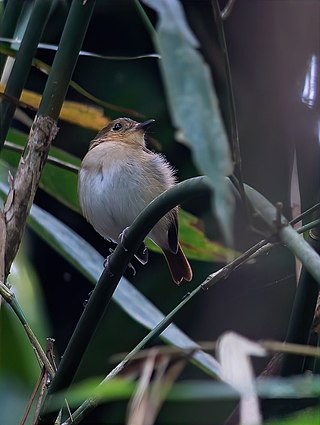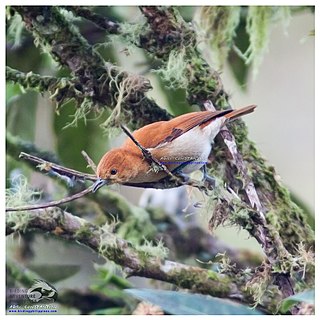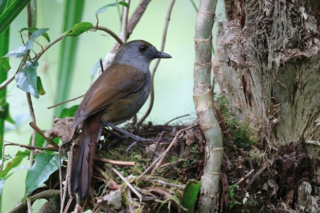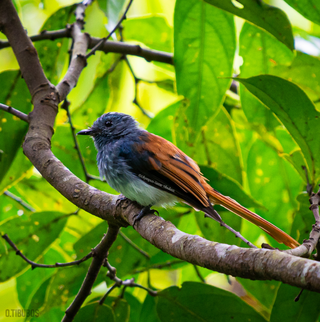The Mindanao brown dove is a threatened species of bird in the family Columbidae. It is endemic to forests on the Philippine islands of Mindanao and Basilan, but it has not been recorded from the latter island since 1937. It is threatened by habitat loss and hunting. Until recently, it was considered conspecific with the Tawitawi brown dove and collectively called the dark-eared brown dove.
The Tawitawi brown dove, also dark-eared brown dove, is a threatened species of bird in the family Columbidae noted for its orange-peach breast. It is endemic to forests in the Sulu Archipelago in the Philippines. Until recently it was considered conspecific with the Mindanao brown dove and collectively called the dark-eared brown dove. Although threatened by habitat loss, the rate of loss significantly reduced from 2004 to 2007, and it was thus downlisted from Critically Endangered to Endangered status in the 2007 IUCN Red List.

Hombron's kingfisher or the blue-capped kingfisher is a species of bird in the family Alcedinidae endemic to the Philippines and found only on Mindanao. It is one of the most colorful kingfishers in the country having a dark blue cap and wings with rufous spots, a striped rufous belly, white chin and red bill. Its natural habitats are on the upper ranges of tropical moist lowland forest and tropical moist montane forests. It is threatened by habitat loss.

Lina's sunbird is a species of bird in the family Nectariniidae It is endemic to mountains in the island of Mindanao in the Philippines. It is one of the most striking sunbirds in the country with the male having an iridescent blue color and an orange spot on its yellow breast. It is named after Dioscoro S. Rabor's wife, Lina. Its natural habitat is tropical moist montane forest above 1000 m. It is threatened by habitat loss

The grey-hooded sunbird is a species of bird in the family Nectariniidae. It is endemic to the Philippines. Its natural habitat is tropical moist montane forests.

The yellow-crowned flowerpecker is a species of bird in the family Dicaeidae. It is endemic to Luzon Island in the Philippines. The flame-crowned flowerpecker, which is endemic to Mindanao, was formerly considered conspecific. Its natural habitat is tropical moist montane forest. It is becoming rare due to habitat loss.

The cryptic flycatcher is a species of bird in the family Muscicapidae. It is endemic to the Philippines only being found in the island of Mindanao. Its natural habitat is tropical moist mid-montane forests from 600 - 1,500 meters.

The cinnamon ibon is a species of bird endemic to the mountains of Mindanao in the Philippines. Monotypic within the genus Hypocryptadius, it is classified as an old world sparrow Its natural habitat is tropical moist montane forests and mossy forests above 1,000 metres (3,300 ft).

Mackinnon's shrike, also called Mackinnon's fiscal, is a songbird species of the family Laniidae. Its natural habitats are subtropical or tropical moist montane forests and moist savanna. It is not considered a threatened species by the IUCN.The population of this species is increasing, which is thought to be due to the degradation of nearby habitat. Its common name and Latin binomial commemorate Archibald Donald MacKinnon.

The Mindanao white-eye, also known as the black-masked white-eye, is a species of bird in the family Zosteropidae. The specific epithet honours British zoological collector Walter Goodfellow. It is endemic to the Philippines. Its natural habitat is subtropical or tropical moist montane forest.
The whiskered pitta is a rare species of bird in the family Pittidae. It is endemic to Luzon in the Philippines. This bird is the largest pitta in the country reaching 23 cm long and 116 g in mass. It has a brownish head, blue breast, and red belly. It has broad ash malar or "whiskers". Its natural habitat is tropical moist lowland forest and tropical moist montane forest. It is threatened by habitat loss and trapping. It is one of the most sought after birds by birdwatchers in the Philippines.

The azure-breasted pitta is a species of bird in the family Pittidae. It is a striking and colorful bird having colors of red, azure, green, black and white, It is endemic to the islands of Mindanao, Bohol, Leyte and Samar in the Philippines. Its natural habitat is tropical moist lowland forest. It is threatened by habitat loss.

The falcated wren-babbler is a species of bird in the family Pellorneidae. It is endemic to Palawan.

The grand rhabdornis, also known as the long-billed rhabdornis or long-billed creeper, is a species of bird currently placed in the starling family, Sturnidae. It is endemic to Luzon Island in the Philippines. It is sometimes treated as a subspecies of the stripe-breasted creeper.

The white-browed jungle flycatcher, also known as the Luzon jungle-flycatcher and the Rusty-flanked jungle-flycatcher, is a species of bird in the Old World flycatcher family Muscicapidae. It is endemic to Luzon island, in the Philippines. The natural habitat of the white-browed jungle flycatcher is tropical moist montane forests. It is threatened by habitat loss.

The Bagobo babbler or Bagobo robin is a monotypic species of bird with its taxonomy undergoing numerous changes and is currently classified as Muscicapidae or an old world flycatcher. It is endemic to the Philippines only found in Mindanao.

The buff-breasted earthcreeper is a species of bird in the Furnariinae subfamily of the ovenbird family Furnariidae. It is found in Argentina, Bolivia, Chile, and Peru.

The Visayan fantail is a fantail endemic to the Philippines on islands of Negros, Panay, Guimaras, Masbate and Ticao. Until recently, it was considered conspecific with the blue-headed fantail and Tablas fantail.
The Visayan rhabdornis is a species of bird currently placed in the starling family, Sturnidae. It is endemic to the central Philippines on the islands of Negros and Panay. It was previously considered a subspecies of the stripe-breasted rhabdornis. It lives in tropical moist montane forest and is threatened by habitat loss.

The flame-crowned flowerpecker is a species of bird in the family Dicaeidae. It is endemic to Mindanao in the Philippines. The yellow-crowned flowerpecker, which is endemic to Luzon, was formerly considered conspecific.
















